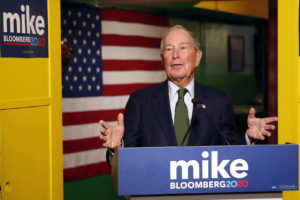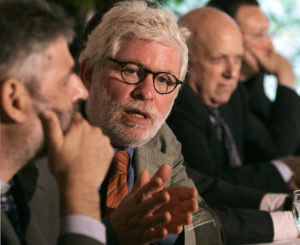A Tool for Dismantling Capitalism Is Hiding in Plain Sight
Geographer Samuel Stein’s captivating new book is an effort to shift the housing discussion away from urbanism and toward socialism. New York City. (Aurelien Guichard / Flickr)(CC BY-SA 2.0)
New York City. (Aurelien Guichard / Flickr)(CC BY-SA 2.0)
“Capital City: Gentrification and the Real Estate State”
A book by Samuel Stein
Over computerized images of a nondescript early American city and a rushing river, a man with a quiet voice and a delightful Philadelphia accent describes the process by which the city of Franklin developed its first water distribution system. The Goodhill Water Works, the voice explains, was created after a series of yellow fever outbreaks that the city blamed on contaminated local water. This led town elites to decide that a new water source was required for the growing municipality. Despite the fact that the state-of-the-art space doubled as a tourist attraction while it pumped fresh water straight into town, residents could only access the water if they had the money to pay for installation and a subscription. Otherwise, they would have to use the few free fountains placed around the city. The bulk of the city’s residents — including indentured servants, a small number of enslaved people, and free workers — had no time, money, or, in some cases, freedom to take in the beautiful grounds and stunning architecture. For them, despite this impressive achievement on the road to their city’s modernization, it was more or less as if nothing had changed at all.
Franklin, as you may have guessed, is not a real place. It is the creation of Justin Roczniak, who publishes a series on YouTube (where he goes by donoteat01) using the video game “Cities: Skylines” to explore the historical development of cities, and to discuss how inequality has been built into American cities from their earliest moments. Starting with an Indigenous settlement along a river, Roczniak describes the displacements and conflicts that have gone into city-building, as well as developments such as the carceral system and organized labor. A self-described socialist, Roczniak uses this historical narrative to examine “how we view cities and what cities are capable of,” as he told Kotaku last year.
The series weds the often wonkish world of urban planning discourse to the pop culture juggernaut that is gaming, and in doing so claims a space in both fields for leftist analysis. And both urban planning and gaming are in dire need of some socialism. In recent years, the public urban planning conversation has been dominated by “urbanism,” a bland quasi-progressive ideology that typically lacks any coherent class or power analysis. Now a dominant tendency among city-planners and many municipal politicians, urbanism treats procedural changes like tweaks to zoning laws as key to solving the problems of the modern city.
Because urbanism dominates discussions about cities — about what ails them and how to fix them — structural analyses have been sorely lacking. The discourse around gentrification still focuses too much on fancy coffee shops and not enough on systematic disinvestment in areas inhabited by people of color and the working class. For urbanists, unaffordable housing can be solved by increasing the amount and density of housing units through “upzoning,” while a more structural analysis would focus on rent control or building more public housing.
Much like Roczniak’s YouTube series, Samuel Stein’s captivating “Capital City: Gentrification and the Real Estate State” is an effort to shift the discussion away from urbanism and toward socialism. Stein offers a planner and geographer’s perspective on the way the city works today, but also shows that planners — even those interested in dismantling oppressive systems — often uphold the power of capital. “[C]apitalism makes the best of planning impossible,” he writes. “[A]ny good that planners do is filtered through a system that dispossesses those who cannot pay.” It is clear that Stein is interested in recuperating a more expansive set of possibilities for cities and city-dwellers than exists under capitalism, and that he sees planning as an avenue toward them. “Capital City” ultimately shows that socialists belong in the public conversation about cities — a conversation that has long been controlled by neoliberal politics ranging from austerity on the right to urbanism on the center-left.
“Capital City” begins with a brief history of planning as both practice and profession. Stein shows how race and class often determine the way that space is structured in the United States. In addition to noting the racist practices of redlining and segregation, Stein discusses a foundational aspect of American history that has often been ignored in mainstream discussions of how cities and space are apportioned: the displacement and genocide of Indigenous peoples. He shows that settler colonialism has been — and continues to be — key to the establishment and expansion of American cities. As Europeans arrived on the land now known as the United States and dispossessed Indigenous nations, they engaged in a “spatial form of primitive accumulation,” building their early towns’ street grids over top of Indigenous settlements and trails.
Click here to read long excerpts of “Capital City” at Google Books.
After outlining this history, Stein lays out his book’s central argument: in recent decades, the financialization of real estate has given rise to what he terms the “real estate state.” Real estate capital exerts inordinate power over the levers of government, he argues, taking advantage of deindustrialization to extract value from cities. “When manufacturing firms exited post-war urban centers,” Stein writes, “they left behind not just a tremendous amount of property but also a political vacuum.” Real estate capital was perfectly situated to take advantage of the glut of now-empty warehouses and abandoned space, and, because it was necessarily “place-based,” it had always been a presence in local politics.
As politicians sought to fill the gap left by the disappearance of industry, many aligned with development-friendly movements and explicitly pushed for gentrification as a way of “renewing” city cores. Desperate to retain capital investment — a desperation that remains today, as the grotesque municipal competition for Amazon’s “HQ2” illustrated — cities have taken to enticing developers and real estate investors with “geobribes.” One of the most egregious examples that Stein names is Tax Increment Financing, a “widely used development incentive” in which a city designates a “blighted” area, issues bonds to pay for infrastructure upgrades, and then gives the improved area over to a private developer to build private housing or retail space. The city is responsible for making the bondholders whole whether the area is profitable or not; meanwhile, if it is profitable, the developer accrues most of that windfall (save whatever they pay in taxes), and another neighborhood is dramatically gentrified. Strategies like these allow real estate developers to reap profits through a cruel, mutually constitutive process of dis- and hyper-investment (the latter is more commonly called gentrification).
While much of the United States is experiencing disinvestment, rarefied areas are experiencing a flood of capital invested in land and property, resulting in skyrocketing costs of living. The two processes go hand in hand, Stein explains: disinvestment causes property values to crater and leads better-heeled (often white) residents to depart, typically taking needed community services and amenities with them. These declining property values then create the conditions for a new round of hyper-investment, which takes advantage of a gap between profit potential and existing value. In other words, disinvestment causes property values to decline enough so that developers can come back, years or decades later, and make a killing, sweeping up now-cheapened real estate and “flipping” it for sale to a new round of gentrifying buyers.
Despite writing that real estate capital’s power is a global phenomenon, Stein is overwhelmingly focused on the United States, and specifically New York City; readers from outside this epicenter of real estate capital will largely be left to draw their own conclusions about how Stein’s analysis relates to their own surroundings. But there are good reasons to focus on New York City too. First, as Stein acknowledges, it is the city he lives in and knows best. More importantly, the focus on New York City allows Stein to draw on the city’s history as a site for early and extreme experiments in financializing the spaces in which we live.
The city was a leader in public housing and rent control in the first several decades of the 20th century, owing largely to well-organized tenants’ movements. Yet after the financial crisis of the 1970s, it led a different way — rapidly reversing those earlier working-class gains. Stein explains that New York was pulled back “from the brink of bankruptcy” by a coalition of “banks, real estate interests and municipal unions, who disciplined the city through a process of privatization and disinvestment from social services that continues to this day.” Local politicians, restrained and still smarting from their brush with economic disaster, were eager to appease capital. In addition to buying up abandoned industrial spaces, enterprising real estate interests began to eye neighborhoods that had low property values due to the longstanding racist practice of redlining (by which black residents were forced into specific neighborhoods that were then systematically underserviced). They saw in both locations an opportunity to capitalize on disinvestment. By converting industrial space for residential purposes, pushing out poor (mostly nonwhite) residents, improving existing housing stock, and replacing it with more luxurious spaces, landlords and developers attracted higher-income residents, raised property values, and remade whole segments of the city “from places into products.”
Today, New York is a playground for the wealthy where thousands of luxury apartments sit empty, serving as some business tycoon’s fifth pied-à-terre, as the workers who make the city run crowd into cramped apartments or, worse yet, don’t have a home at all. The situation has been exacerbated by city and state governments happy to sell out working-class residents in favor of private investment.
To illustrate this last point, Stein looks at the policies of New York’s two most recent mayors: incumbent Bill de Blasio and billionaire business magnate Michael Bloomberg. Though the two are often framed as polar political opposites, with Bloomberg prioritizing corporate interests and de Blasio a progressive, Stein shows that, in many ways, de Blasio has continued Bloomberg-era real estate policies that have allowed investors and developers to run roughshod over what was once a livable city for the 99 percent.
Both Bloomberg and de Blasio have used zoning as a way to reshape certain areas of the city. Bloomberg’s practice was to rezone neighborhoods. Stein writes that there was a specific, racist character to Bloomberg’s pattern of upzoning primarily working-class, black areas while, in essence, protecting the character and value of primarily white neighborhoods. By contrast, de Blasio has been a proponent of inclusionary zoning, and so is widely seen as progressive by urbanist types. Stein, however, does a superb job of describing exactly why de Blasio’s policy does not deserve that reputation. Because it requires some (usually small) number of housing units in a new development to be “affordable,” it relies on building more unaffordable housing in order to add a small number of affordable housing units in a given development (and even then, the measure of an “affordable” apartment is unreachable for many New Yorkers). De Blasio’s metric for “affordability,” while an improvement over Bloomberg’s, still effectively prices out 57 percent of New York’s Black and Latinx residents.
Stein ends with a set of prescriptions for how radical planners might seek to use the tools at their disposal to “unmake the real estate state.” He is attentive to the difficulties that this call to action involves: “All consciousness is contradictory,” he writes almost apologetically, “but the situation for capitalist urban planners is especially thorny. They are simultaneously far-seeing visionaries and day-to-day pragmatists.” Ultimately, however, he sees promise for radical planning within the capitalist state (and this despite his earlier claim that by helping establish spatial order in capitalist states, “planners — whatever their intention — are working for the maintenance, defense and expansion of capitalism”). At the close of his book, Stein suggests that leftist planners could both make use of existing tools and widen the horizons of what is possible. In answer to the perennial question “reform or revolution,” it seems Stein would echo the little girl in the meme who asks, “Why not both?”
In this prescriptive section, Stein has something to offer almost everyone. Are you merely dipping your toes in the idea that the capitalist city has problems? Perhaps you’d be interested in using inclusionary zoning to target wealthy white neighborhoods for integration or protecting working-class areas with preservation policies. Skeptical about the prospect of repurposing tools originally designed for the benefit of the white and the wealthy? You might want to move on to socializing land and “unmaking the social relations that produce capitalist private property.” If that gives you pause and makes you ask how, exactly, we are supposed to accomplish such a goal, it’s time to look at the final section of this chapter: politics. Here, Stein readily acknowledges that planners cannot unmake the real estate state on their own — not even close. Mass politics that both forcefully advocate for specific goals and “make the status quo untenable” are integral to the process.
It’s clear from his prescriptions that Stein sees a joint effort between mass political movements and radical, avowedly anticapitalist planners as a fruitful path. Yet this prescription, simultaneously the most ambitious and the most realistic for actually effecting lasting change, feels tacked on given how vanishingly little space activists and organized grassroots politics are afforded throughout the book. He might have discussed previous examples of collaborations between planners and activists — collaborations that sometimes worked well and other times resulted in disaster. While groups like the Planners Network put progressive planners to work with community organizations, the midcentury project of “urban renewal” involved razing “blighted” (usually poor and/or nonwhite) areas to create new and apparently improved housing or retail, displacing existing tenants and disrupting their communities. A more comprehensive exploration of the complex historical relationship between planning and activism, and the tensions and possibilities in that pairing, might have grounded the analysis in a way that would give his conclusions more force.
Nevertheless, “Capital City” is a fascinating read for anyone interested in cities, capitalism, racism, or housing. It will undoubtedly be a great resource for socialists who are looking for common ground with urbanist friends or family (or a friendly method of radicalization). Stein has produced a book that is concise and digestible, without sacrificing analytical heft. Socialists are re-entering the popular conversation about cities from coast to coast, reminding people that winning another world is not only possible but necessary, and that we can only do it together. Stein’s work is an important addition to this movement, and, crucially, a promising tool for introducing more people to these ideas.
This article originally appeared on the Los Angeles Review of Books.
Your support matters…
Independent journalism is under threat and overshadowed by heavily funded mainstream media.
You can help level the playing field. Become a member.
Your tax-deductible contribution keeps us digging beneath the headlines to give you thought-provoking, investigative reporting and analysis that unearths what's really happening- without compromise.
Give today to support our courageous, independent journalists.








You need to be a supporter to comment.
There are currently no responses to this article.
Be the first to respond.